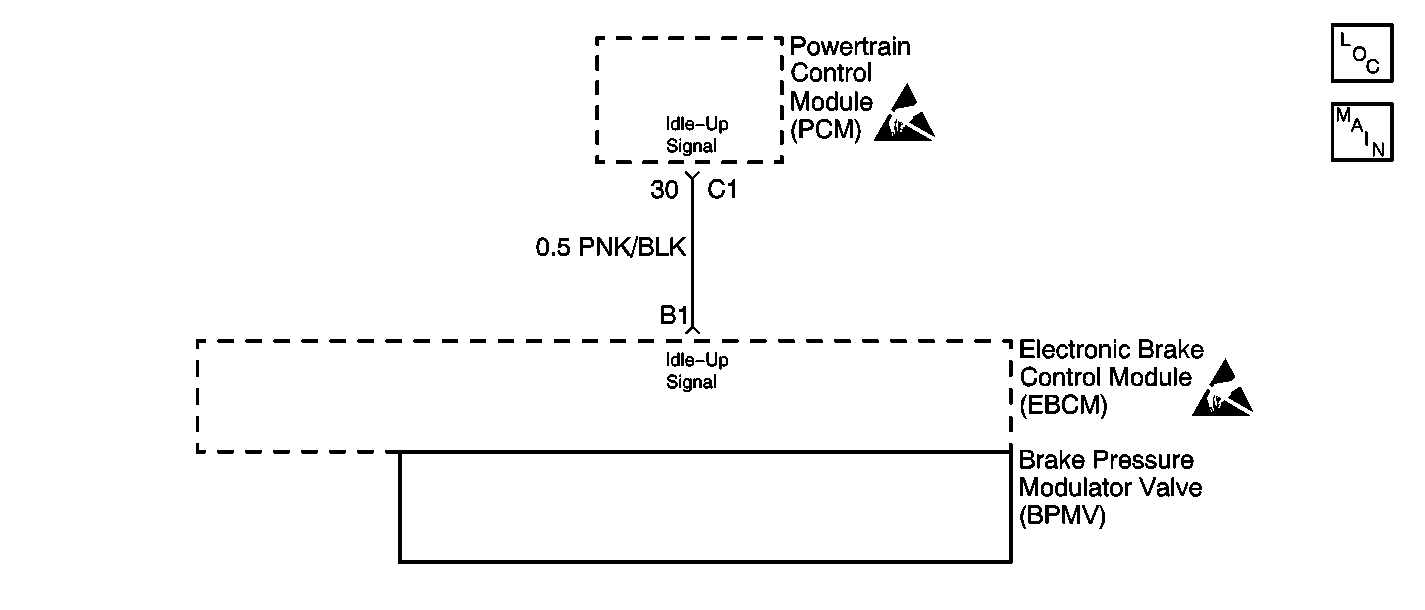
Circuit Description
The EBCM uses the Powertrain Control Module (PCM) to increase the engine idle speed during certain ABS events, especially those on icy road conditions. The EBCM is connected to the PCM through the Idle Up circuit. When deemed necessary, the EBCM grounds this circuit which signals the PCM to increase idle speed from 850 rpm to 1500-2000 rpm. If an open or short to voltage occurs in the Idle Up circuit, the EBCM will be unable to request the PCM to increase engine speed.
If a short to ground occurs in the Idle Up circuit, the PCM will increase the engine idle speed continuously, once the vehicle speed has reached at least 20 km/h (12 mph).
Conditions for Setting the DTC
This DTC will set when the following conditions are met:
| • | This DTC can be set anytime after initialization for an open or short to ground in the Idle Up circuit. |
| • | The EBCM can detect a short to voltage in the Idle Up circuit only during the time that the EBCM is requesting the PCM to idle-up. |
Action Taken When the DTC Sets
| • | A malfunction DTC stores. |
| • | ABS remains functional. |
Conditions for Clearing the DTC
| • | The condition responsible for setting the DTC no longer exists and the Scan Tool Clear DTCs function is used. |
| • | 100 drive cycles pass with no DTCs detected. A drive cycle consists of starting the vehicle, driving the vehicle over 16 km/h (10 mph), stopping and then turning the ignition OFF. |
Diagnostic Aids
Use the enhanced diagnostic function of the Scan Tool in order to measure the frequency of the malfunction.
Any circuitry that is suspected of causing the intermittent complaint should be thoroughly checked for improper mating, improperly formed or damaged terminals, poor terminal to wiring connections, or physical damage to the wiring harness.
Step | Action | Value(s) | Yes | No |
|---|---|---|---|---|
1 | Was the ABS Diagnostic System Check performed? | -- | Go to Step 2 | |
2 |
Was a problem found and corrected? | -- | Go to Step 3 | |
3 |
Note: If the speed of the driving wheels drop below 25 km/h (15 mph) while commanding ON the Idle-Up Circuit, the PCM will ignore and requests to idle-up from the EBCM. This is a normal condition. Repeat Step 7 above if needed. Notice if the engine rpm increases from idle speed to 1500-2000 rpm when the Idle Up Circuit is commanded ON during this test. Does engine speed increase as described? | -- | Go to Step 5 | Go to Step 4 |
4 |
Is the voltage measured within the range specified when Idle Up Circuit is commanded ON? | 0-1 V | Go to Step 6 | Go to Step 7 |
5 | Malfunction not present at this time. Refer to Diagnostic Aids for additional information regarding this DTC. Is the action complete? | -- | -- | |
6 | Replace the PCM. Refer to Powertrain Control Module Replacement/Programming . Is the repair complete? | -- | -- | |
7 | Inspect the EBCM connector for poor terminal contact, open or high resistance in the Idle Up circuit. If the wiring is OK, replace the EBCM. Refer to Electronic Brake Control Module Replacement . Is the repair complete? | -- | -- |
